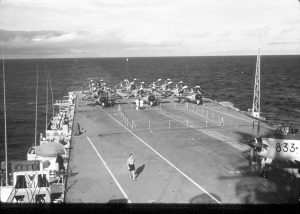- Author
- A.N. Other
- Subjects
- Naval Aviation, Naval technology
- Tags
-
- RAN Ships
- HMAS Melbourne II
- Publication
- December 2011 edition of the Naval Historical Review (all rights reserved)
Despite earlier talk of discontinuing fixed wing aviation in the RAN, 1965 brought with it new hope for the future of Naval fixed wing aircraft6. Previous fears that fixed wing aviation in the RAN was too costly were voided by a reappraisal of the Naval Three Year Plan which outlined the effective benefits of fixed wing aircraft in a maritime environment. As a result, the Australian Government ordered ten new McDonnell Douglas A-4G Skyhawk aircraft7. These new Skyhawks replaced the Sea Venom aircraft in its fighting role aboard Melbourne. A much more capable platform, the Skyhawk could achieve greater speeds with higher agility than the Sea Venom, and was a more durable aircraft well suited to the rigours of carrier operation. These factors allowed the Skyhawk aircraft to quickly make a name for itself in the RAN as an effective fighting platform with a highly increased operational capability than any previous aircraft. June 1962, during SEATO exercises, saw a successful co-ordinated attack on an enemy surface action group. This successful attack signified the first attack in the RAN where Tracker aircraft and Skyhawks worked closely to achieve a simulated surface kill8. This was a significant milestone as it showed the differing capabilities of the radial piston powered Grumman S-2 Tracker used for scout and search operations, and the gas turbine Skyhawk that performed the attack on the located units.
The Skyhawk was a potent ship striking force that elevated Australia in the international sea power hierarchy, but the aircraft were not able to be utilised effectively without the use of modern aircraft carriers for base support. However Melbourne was decommissioned in June 1982, spelling the end of carrier operations for the RAN’s Skyhawk aircraft9. The Skyhawks remained in service for a further two years operating as a land based surface strike capability before being sold in New Zealand and ironically returning as part of an RNZAF Squadron to operate again from NAS Nowra in 1991.

RAN
The introduction of jet power to fixed wing aircraft in the RAN was especially significant in a variety of ways. Firstly the range of roles that fixed wing aircraft could perform was broadened, allowing the remainder of the service to keep up with advances in technology such as radar aided aircraft detection. More powerful aircraft allowed weapons technology advances to be implemented to strike aircraft, and with gas turbine power, aircraft could remain airborne for a longer duration flying at greater speeds and greater distances, allowing more intricate missions to be flown.
Helicopters
In 2000, soon after the decommissioning of the Skyhawk and Tracker fleets, the RAN became an all helicopter aviation service with 723 Squadron operating the AS350BA Squirrel, 816 Squadron operating the S-70B-2 Seahawk, and 817 Squadron operating the Westland Sea King Mk50A, all jet powered, rotary wing aircraft.
While the RAN had taken delivery of three Bristol HR Sycamore helicopters in March 1953 it had predominantly flown fixed wing aircraft throughout history. In the year 2000, slightly less than 50 years later, RAN squadrons were flying only helicopters. Fixed wing aircraft were no longer viewed as valuable assets due to the roles required of RAN aircraft, and the RAN’s lack of any surface platform capable of launching and receiving them.
The Sycamore aircraft were employed as a logistics and medium lift capability. They had the ability to operate from ships other than carriers, providing the RAN with a new logistic capability. As helicopters began to be equipped as an anti-submarine capability, fuel efficiency became a primary objective in order to increase the ship’s anti-submarine warfare range. In 1962, the Westland Wessex entered service to provide an anti-submarine warfare (ASW) capability. Despite the Wessex’s impressive capability, it was becoming obsolete quickly as the decade progressed.
Less than 10 years later, the RAN was forced to search for a replacement aircraft, and in 1976 the Westland Sea King Mk50 entered service in 817 Squadron10. This dual turboshaft platform was adaptable to a variety of hardware, and throughout its career as an anti-submarine warfare platform, the Sea King was fitted and refitted with a multitude of radar equipment. The Sea Kings provided an anti-submarine capability until 1995 when they were stripped of their sonar sensors. From this point the Sea King was employed as a utility support platform with a medium heavy lift capability.




